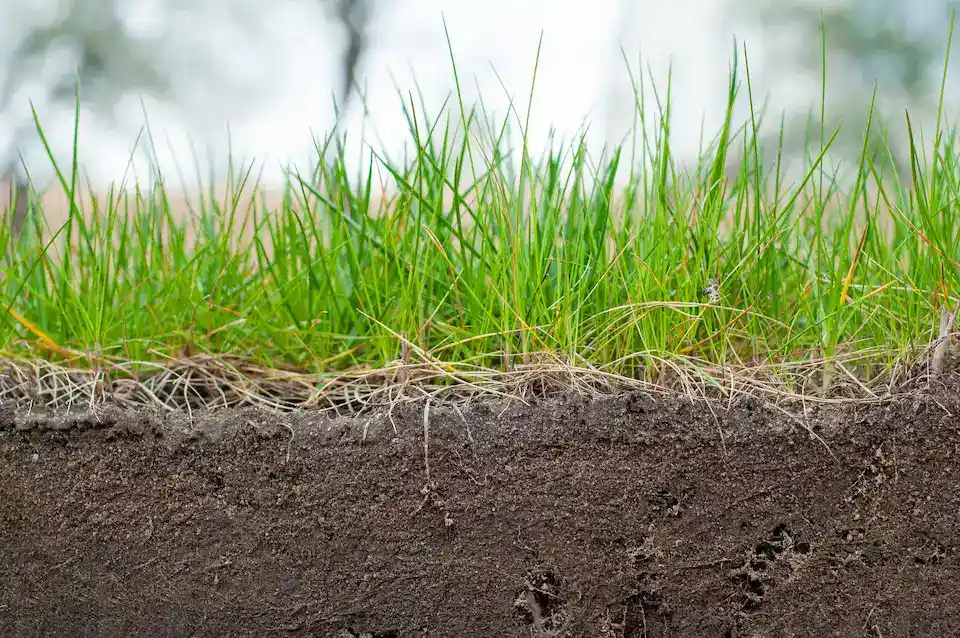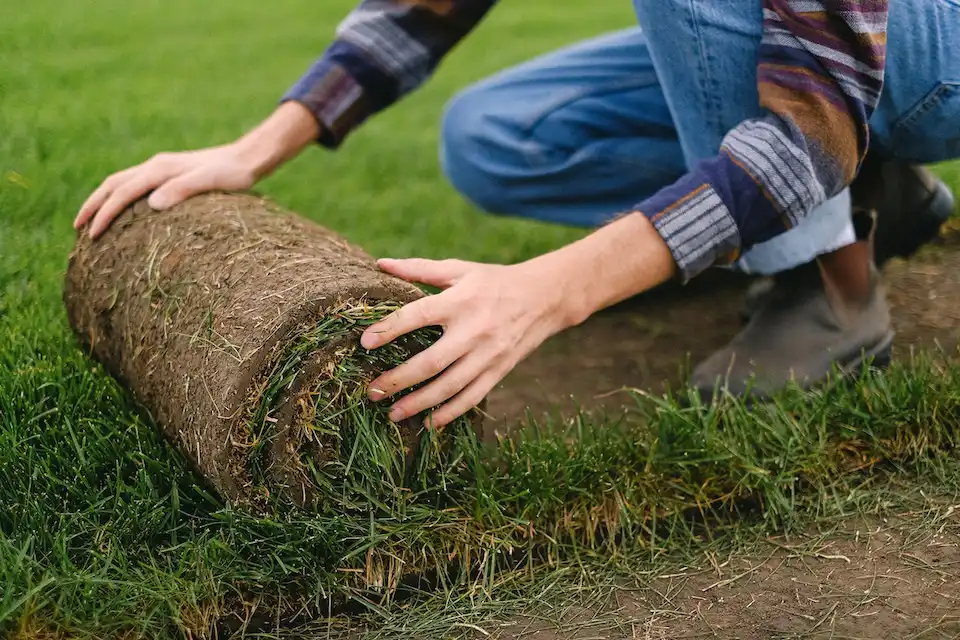The Cost of Sod in North Carolina: A Comprehensive Guide to Sod Installation
Whether you’re a homeowner looking to transform your backyard or a business owner seeking to enhance your commercial property, understanding the expenses involved in sod installation is crucial. From the initial investment to ongoing maintenance, our Raleigh landscaping experts are breaking down the various factors that influence the cost of sod.
Our hope is to provide you with valuable insights to make informed decisions on the landscaping needs of your home or business property. Join us as we unravel the secrets behind achieving a lush and vibrant lawn by examing how much it costs to install sod in North Carolina.

Understanding Sod Installation
Installing sod grass refers to the process of transforming a bare or damaged area of land into a lush and vibrant lawn by laying down pre-grown sections of grass, known as sod. Unlike traditional seeding methods, sod installation in Raleigh and Wake Forest, NC provides an instant, fully-grown lawn without the need to wait for seeds to germinate and grass to mature.
The process typically involves several steps, including site preparation, soil evaluation and amendment, removal of old grass, leveling the ground, and carefully laying down the rolls of sod in a precise and organized manner for a new, green lawn.
Sod installation offers numerous benefits, such as:
- Immediate results
- Reduced soil erosion
- Enhanced curb appeal
- Quicker establishment of a healthy and weed-free lawn
The Cost of Sod in North Carolina
When it comes to transforming your outdoor space with sod, it’s important to have a clear understanding of the cost of professional installation to lay sod as well as the sod installation costs if going the DIY route. A recent study done by North Carolina State University found that local sod installation cost ranges from $0.45 to $0.56 and average at $0.51 per square foot.
How Many Square Feet is a Roll of Sod?
The square footage of a roll of sod can vary depending on the specific dimensions of the roll. However, a standard roll of sod typically covers an area of about 10 square feet. These rolls are typically cut into long, rectangular pieces that are easy to handle and install. The dimensions of a standard roll of sod are often around 2 feet in width and 5 feet in length.
The size of sod rolls can differ between suppliers or sod farms. Some may offer larger rolls that cover more square footage, while others may provide smaller rolls for easier handling or specific project requirements. To get an accurate estimate of the number of sod rolls needed for your project, it is recommended to measure your lawn’s square footage and consult with a local sod supplier or Raleigh landscape design professional.
Is it Cheaper to Reseed or Sod?
Determining whether reseeding or sodding is cheaper depends on various factors and the specific conditions of your lawn. Let’s explore the cost considerations of each method.
Reseeding
Reseeding generally involves purchasing grass seed and applying it to your lawn. The cost of grass seed can vary depending on the type and quality of seed you choose. It is typically less expensive than purchasing sod. However, additional costs may arise for tools such as a seed spreader, topsoil or compost for soil preparation, and any necessary fertilizers or soil amendments.
Sodding
Sodding provides an instant lawn, eliminating the waiting time for grass to grow. While the upfront cost of purchasing sod is generally higher than buying grass seed, sod installation often requires less ongoing maintenance compared to reseeding. Sodding can be a cost-effective option if you want quick results and are willing to invest more initially.

Factors Affecting Sod Cost in North Carolina
Let’s explore the several factors that affect the cost of sod in North Carolina.
Grass Type
Different grass varieties have varying prices based on factors such as availability, maintenance requirements, and desired characteristics. Consider the common grass types when determining materials for planting new grass in NC. These include Bermuda grass, Zoysia grass, and Fescue grass, each with its own price range.
Quantity
Sod is typically sold by the square foot, so the larger the area, the more sod you’ll need and the higher the cost.
Supplier or Landscaping Company
Factors such as their location, overhead costs, and quality of service can influence the prices charged by suppliers or sod landscaping companies. It’s advisable to compare prices from multiple sources to find the most competitive option.
Delivery Charges
The distance between the supplier or sod farm and your property, as well as the quantity of sod being delivered, can impact the delivery costs.
Site Preparation
If your soil requires additional amendments or leveling, these expenses will be added to the total cost of the sod installation project.
Labor Costs
If you choose to hire professionals for sod installation, labor costs will contribute to the overall expense. The complexity of the job, including site preparation, sod laying, and any additional services required, will influence the labor cost.
Maintenance Requirements
Different grass types have varying maintenance needs, which can impact the long-term cost of maintaining your sodded lawn. Consider factors such as watering, fertilization, mowing, and weed control when assessing the overall cost of sod installation.
Laying Sod: Steps to a Successful Installation
Sod installation is an effective way to achieve an instant, lush lawn. To ensure optimal results, it’s important to follow the proper steps for laying sod.
Preparing the Ground for Sod Installation
The first step of sod installation is to prepare the ground for the new turf. Here are the steps to get the ground ready for your sod if opting for a DIY sod installation project:
- Clear the area: Remove any existing vegetation, rocks, or debris from the area where you’ll be laying the sod.
- Soil preparation: Assess the quality of the soil and make any necessary improvements. This may involve loosening compacted soil, removing weeds, and adding organic matter or topsoil to enhance nutrient content and drainage.
- Level the ground: Use a rake or leveling tool to create a smooth and even surface for the sod to be placed on. This will help prevent unevenness and promote proper rooting.
Consider having your soil tested. By taking a sample of your soil and sending it to a lab for testing, you can get a detailed report on the nutrients and minerals present in your soil. This information can be used to make informed decisions about improving your land’s fertility, increasing crop yields, and making everything look healthy and beautiful year-round.
Properly Laying Sod for Optimal Results
For the best results, it’s important to follow this process of laying sod:
- Start with the edges: Begin laying sod along the edges of the area, ensuring they are tightly butted against each other. This will provide a neat and seamless appearance.
- Stagger the seams: Offset the seams of each sod row, similar to how bricks are laid, to enhance stability and prevent visible lines.
- Firmly press down: Gently press the sod into the prepared soil to establish good contact between the roots and the ground. This will facilitate proper rooting and ensure successful establishment.
- Trim and shape: Use a sharp knife or sod cutter to trim and shape the sod as needed to fit around obstacles like trees, flower beds, or pathways.
Post-Installation Care for Your New Sod
Post-installation care is crucial for the success and long-term health of your newly laid sod. Here are some essential guidelines to follow for proper post-installation lawn care.
Watering
Immediately after sod installation, thoroughly water the entire area. The goal is to ensure that both the sod and the soil underneath are adequately hydrated. Watering helps the roots of the sod make contact with the soil and promotes proper establishment. It’s important to keep the sod and soil consistently moist for the first couple of weeks after installation.
Avoid Foot Traffic
Minimize foot traffic on the newly laid sod for the first few weeks to allow the roots to firmly establish themselves in the soil. Walking or placing heavy objects on the sod too soon can disrupt root growth and potentially cause damage.
Mowing
Once the sod has rooted and reached a height of about 3-4 inches, you can start mowing it. However, make sure not to remove more than one-third of the grass height in a single mowing. Set your mower to a higher setting to avoid cutting the grass too short, as this can stress the sod. Regular and proper mowing practices help promote healthy growth and maintain an even lawn height.
Fertilization
Depending on the grass type and soil conditions, applying fertilizer to your new sod may be beneficial. Consult with a local lawn fertilization expert or follow the recommendations of the sod supplier for the appropriate timing and type of fertilizer to use.
Weed Control
It’s essential to monitor your newly sodded lawn for any weed growth. Weeds can compete with the grass for nutrients, sunlight, and water, hampering the establishment of your sod. Hand-pull or spot-treat any weeds that appear, following safe and effective weed control practices. Avoid using herbicides or weed control products that may harm the newly laid sod.
Ongoing Maintenance
As your sod continues to establish and mature, it will require regular maintenance. This includes routine mowing, fertilization, proper irrigation, and addressing any specific needs of the grass type you have installed. Follow a consistent lawn maintenance schedule and seek advice from professional landscapers for resources specific to your grass type and local climate.
Beautify Your Landscape and Request a Quote for Sod Installation from Turf TitanZ
Ready to beautify your landscape with a stunning, vibrant lawn? Look no further than Turf TitanZ, your trusted sod installation experts in Wake Forest, North Carolina. Whether you’re a homeowner or a business owner, our team is ready to transform your outdoor space with professional sod installation.
Don’t wait any longer– take the first step towards a lush and inviting lawn. Contact our professional residential and commercial landscaping design team today to request a quote for sod installation.
To get started give us a call at (919) 562-0771 or fill out the contact form below.
